African violets are one of the most well-liked houseplants in the world. These compact, low-growing plants bloom several times yearly and come in many leaf forms and colors. In addition to their evergreen foliage, African violets have a rosette of thick, fuzzy leaves topped with violet-like flowers. With the right growth conditions, African violets can bloom all year round in an indoor garden.
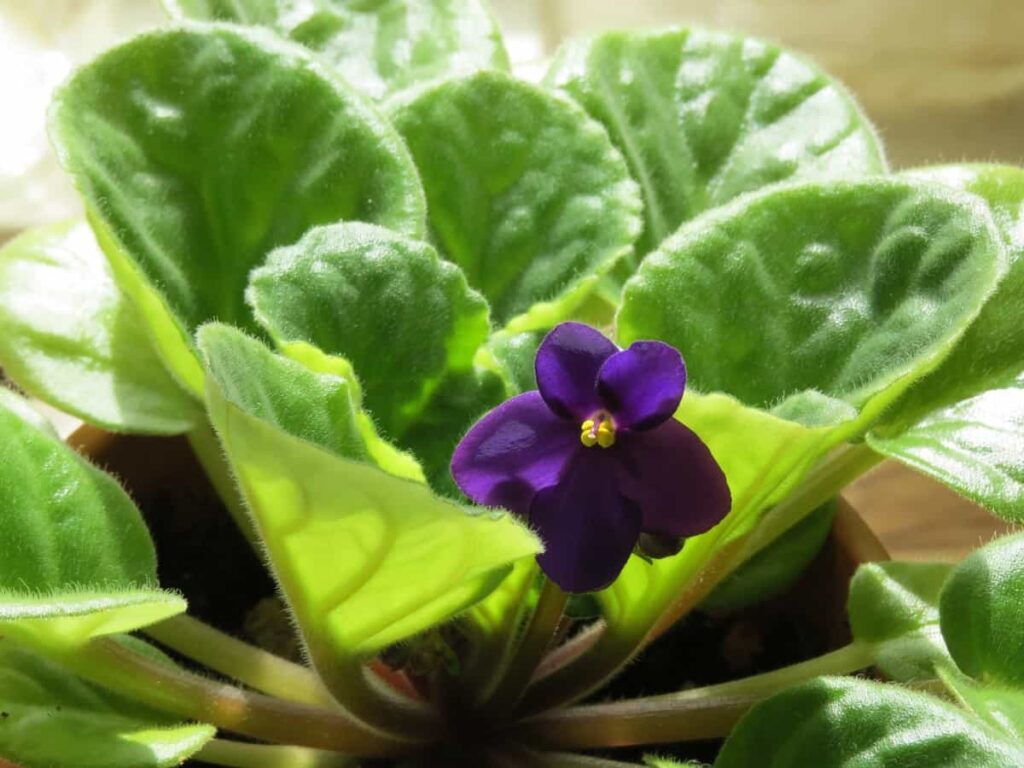
These lovely houseplants come in almost 16,000 varieties. Lavender, soft pink, purple-blue, and pure white flowers can be grown, and some varieties feature double-petaled that blooms in various colors. The plants can range in size from 6 inches in diameter to more than 16 inches in diameter. When you practice a little, you can keep them blooming throughout the year.
How to grow African violets
Types of African violets
There are single and double African violet flowers and frilled and shaped flowers. Their flowers have many colors, and their leaves can be found in various shapes. Several trailing plants are available, including single-crown and multi-crown plants. Some examples are listed below.
Persian Prince
Usually, Persian violets only live for two growing seasons; they are biennial flowering plants. It is commonly grown as a houseplant, but it is possible to grow these violets outdoors in tropical and subtropical regions. Despite its rapid growth, the plant remains relatively small, but it’s pretty eye-catching. There are a lot of small, ovate, glossy dark green leaves on this plant. Blue-violet, star-shaped flowers with yellow centers bloom profusely in spring and summer, though reblooming is possible under ideal growing conditions.
Aroma of summer
The aroma of Summer has a distinct, pleasant scent, as suggested by its name. It is impossible to choose the most beautiful African violet variety, but this plant’s pink and white petals contrast with its dark-green foliage, making it the most attractive.
Lonestar snowstorm
The white blooms of this standard variety are adorned with frills around the edges, giving them a lace-like appearance. In the center, the leaves are dark green, but the pigment fades to beige as it approaches the edge. The African violet is a beautiful, unique plant that would look lovely in any home.
Summer twilight
This variety is an eye-catching specimen featuring classic purple petals with white ruffled edges. There are large, eye-catching flowers, but there are also various leaves. At the center of the leaves are dark green; at the edges, they become light green and beige.
IAN Minuet
This variety is a showstopper featuring large pink flowers with wavy red edges. A large number of blooms are produced by the African violet, which has medium-green foliage. In addition to producing beautiful blooms so readily, this variety is highly sought-after.
High School Sweetheart
When it comes to African violets, High School Sweetheart is the variety you need if you want a bold variety. There are bright pink blooms with light-green ruffled edges. This arrangement is guaranteed to catch everyone’s attention with its vibrant blooms and dark foliage.
Julia
Purple blooms resemble a ball, and the edges of the ruffled petals are slightly darker than the center of this unique African violet variety. Any collection of African violets would benefit from this beautiful specimen, which stands out from other species.
In case you missed it: How to Grow Desert Roses: Varieties, Soil, Planting, Pruning, Fertilizers, and Care
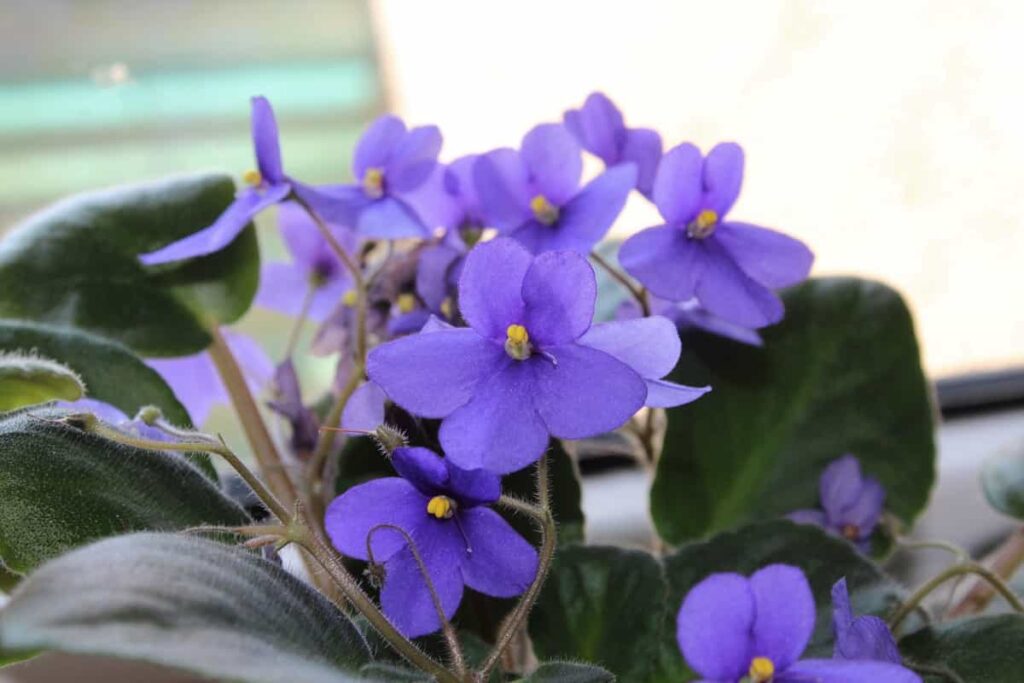
How to propagate and grow African violets from leaf cuttings
Tanzania, Kenya, and other parts of East Africa are home to African violets, a group of flowering perennial plants. Violets can be grown at home relatively easily, but they require a suitable medium, nutrients, and environment to thrive.
As long as they get all the nutrients they need, African violets will grow all year round, bringing a bit of summer into your home, even in winter. Various methods are available for propagating African violets, including leaf cuttings and offsets. A leaf from an adult plant is relatively easy to propagate. To do this, follow these steps:
- Use scissors to carefully cut off a healthy green leaf from the plant bottom.
- Make a 45-degree cut along the leaf stem to make it 2 inches long.
- Prepare a small pot mixing vermiculite and peat, and then add water. Then put the cutting into the pot.
- A plastic baggie should be placed over the pot, and it should be placed in bright, indirect light.
- It will take about 12 weeks for new plants to appear. You have to wait until they are bigger
- Separate new leaves from the leaf once they are roughly the size of a dime.
- A medium for African violets should be filled into small pots. Leave the medium loose, and do not pack it down.
- Use a pencil or finger to indent the soil in the middle of each pot by half an inch.
- The seedlings or baby plants should be placed gently into the hole in the soil. It is essential to keep all the leaves and stems above the soil. Make sure the extra medium is loosely covering the roots.
- You should add some water to each pot to moisten the medium. Make sure the pots with the new plants are placed in a warm, humid location with lots of indirect sunlight.
- Adult plants occasionally will produce small plantlets or shoots. These should be removed and potted up independently. Also, removing them encourages the parent plant to bloom better.
Propagation by dividing African violet plants
Dividing African violet plants is another easy method of propagating the plant. In the division technique, the plant’s crown is cut off, or pups, or suckers, are separated, ensuring that each piece is attached to the root system of the main plant. With suitable African violet potting soil mix, each piece can be planted in its pot to multiply your collection of African violets instantly. During African violet propagation, follow these steps:
In case you missed it: Vertical Strawberry Farming: A New Way to Increase Your Income and Yield
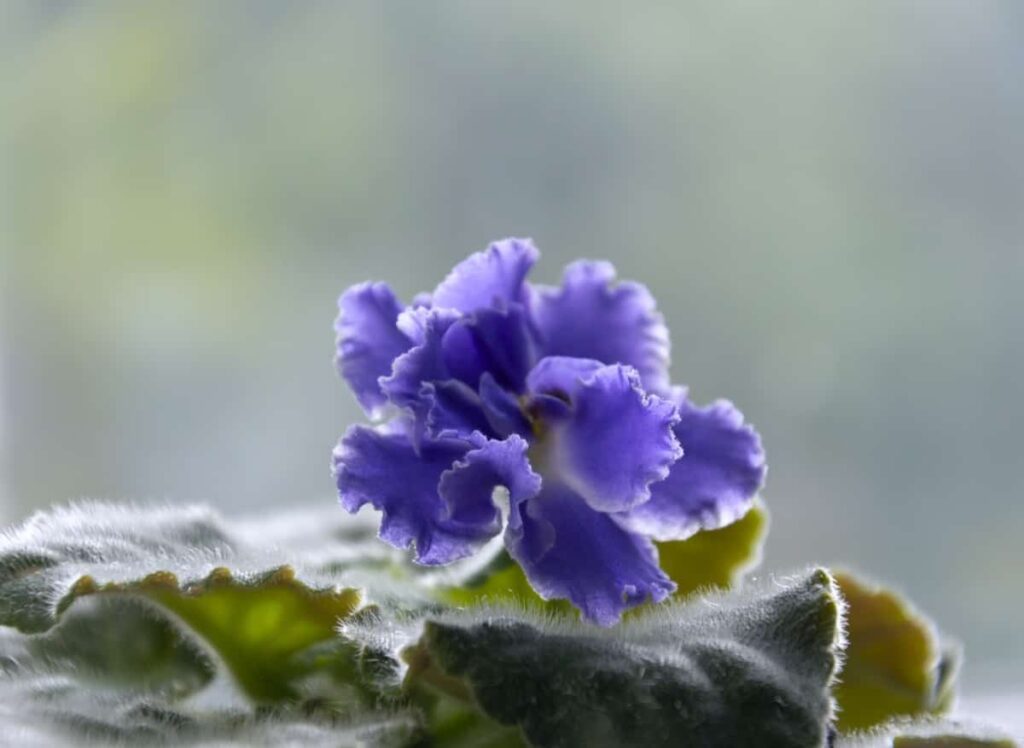
- Water the African violet plant the day before you intend to separate the pups.
- Fill a 2-inch clay or plastic container with a potting mix containing peat, perlite, or any other well-drained mixture. Use a smaller pot rather than a larger one, as too much moist potting mix can cause the pup to rot.
- The mother plant should be carefully removed from the pot, and the leaves should be gently pushed apart to find the pups. Make sure the pup is separated from the mother plant by cutting it with scissors or a sharp knife.
- Place the pup in the pot, then gently firm the potting mix around the stem after making a hole in the pot.
- Put a transparent plastic sheet over the pot and water lightly. The pot will look like a miniature greenhouse. A clean plastic milk jug can also be used with the spout end cut off.
- Make sure the pot is placed in bright, indirect light. Drafts and heating vents should be kept away from the pup.
- The potting mix should be lightly moistened with lukewarm water and never soggy.
- A mixture of 14% balanced, water-soluble fertilizer in one gallon of water should be given to the pup once a week. Before applying fertilizer to the pup, make sure it is well hydrated.
- Fresh air can be provided by opening the bag or removing the cover occasionally. When condensation appears inside the plastic, it is crucial to remove it. After four weeks, remove the plastic cover for a short period and gradually increase the time until the pup no longer feels protected by the greenhouse environment.
African violet care
Bright, warm, and humid conditions are ideal for African violets. Water should not touch their leaves, as it will leave brown spots. When you see dead leaves or flowers, remove them immediately to encourage a healthy plant. Check the soil for excess moisture regularly. Rot will be encouraged by it. It is essential to ensure that all the factors involved in cultivating these houseplants are balanced. A fresh breeze should keep them from getting too stuffy, and they should be exposed to sunlight without damaging their leaves by keeping them moist enough that they don’t dry out. African violets may suffer some damage during the growing process, but do not get discouraged.
Type and how much sunlight is required for growing an African violet
A light that is bright and indirect is best for African violets. Ensure they are kept away from the south or west-facing windows that receive direct sunlight. East- or north-facing windows provide the best lighting for their foliage without burning it.
It is also possible to use artificial lighting. For these plants, fluorescent or LED bulbs can supplement natural light. Typically, they are grown 12 to 15 inches above the leaves under fluorescent lights. The plant receives too little light when the leaves are thin, dark green, and leggy and too much light when the leaves are light green or bleached.
Required soil type and preparation for an African violet
There is a wide range of soil types and mixtures where African violets can be grown. Gardeners achieve the best results when their soil is well-drained, well-aerated, and contains a high percentage of humus. A plant can develop root rot when exposed to standing water for an extended period. It results in the leaves falling off and the plant becoming waterlogged. Two parts loamy topsoil, one part leaf mold, one part peat moss, and one part sand are recommended.
In addition to peat-vermiculite or peat-perlite, artificial mixes can be used to grow violets. Most insects and diseases will not be present since they are relatively clean. Mixtures may contain equal parts of soil, peat moss, and perlite, and vermiculite may replace perlite when necessary. Some violet growers prefer artificial mixtures because they are more consistent in quality than sand and soil. A sterilized potting or commercial African violet soil mixture is best for growing violets.
In case you missed it: Lavender Farming in Jammu and Kashmir: Excellent Profits With Purple Revolution Under Aroma Mission
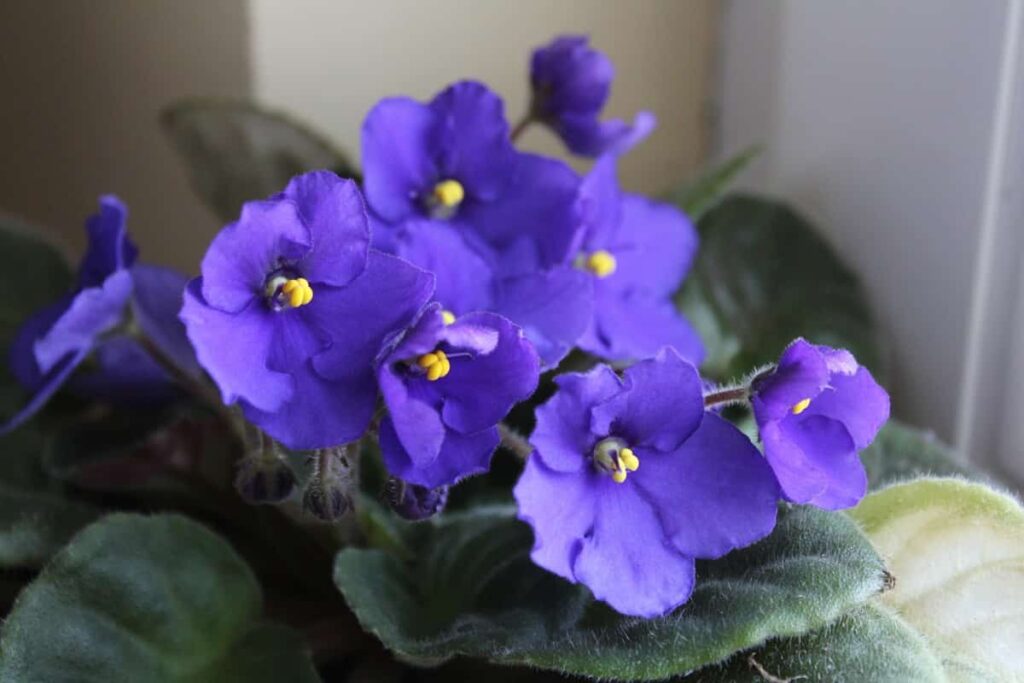
How and when to water your African violet
Ensure the soil is moist with soft, warm water, and strive for high humidity. To prevent damage to plant leaves, do not allow water to contact them other than light misting. When watering, water the plants from below or push the water spout into the soil. Ensure the plant doesn’t sit in water for long periods.
Ensure that the soil is kept lightly moist, but do not overwater, as African violets are prone to rot because of their soft stems. The leaves can be marked by chilled water, so use room-temperature water instead. High humidity can cause rot and fungal spots on African violet leaves, so water from the bottom avoids excess water on the leaves.
Temperature and Humidity for growing an African violet
Violets are most attractive when grown at temperatures between 18°C and 21°C at night and 21°C to 32°C during the daytime. Plants grown at temperatures below 18°C will be deformed. The leaves may be curling down, cupping, and becoming brittle. And also, flowers will be deformed and discolored. At cooler temperatures, foliage may also appear light green. The foliage of plants that grow in drafts or that touch glass window panes may be injured.
It is better to keep plants away from temperatures exceeding 32°C and below 18°C for best results. African violets need high humidity to grow well. Even though violets grow and flower in humidity ranges typical of average homes. High humidity promotes the growth of the most successful plants. It is possible to increase humidity in the home and benefit both plants and people with these devices.
Fertilizer application for an African violet
Every two weeks, fertilize with a high-phosphorous plant food during active growing seasons (spring and summer). Fertilize only when the plant shows slow, thin growth with yellow or pale leaves, which means it needs a boost. Most gardeners prefer to use liquid or water-soluble fertilizers every four to six weeks, such as 20-20-20. It is also possible to use dry fertilizers, slow-release fertilizers, or encapsulated fertilizers.
Before using dry fertilizer, make sure the soil is moist. In most soil mixes, there are plenty of nutrients, so overfertilizing is a more common problem than under-fertilizing. Follow the instructions on the product label for the amount to be used.
Pruning for an African violet
Remove three or more leaves from the bottom of the plant at least once a month to keep it at its healthiest. Regular leaf production balances the appearance of the violet, allowing old leaves to be replaced with new ones. Spend flowers should be removed as soon as they appear. By redirecting energy away from the old flowers, the plant will be able to grow new flowers.
Additionally, it enhances the plant’s appearance and promotes airflow. With your forefinger and thumb, African violets can be pruned by pinching off leaves and flowers. Alternatively, you can use sterilized scissors. Remove plant material from the base without cutting into the main stem.
In case you missed it: Croton Plant Care in India: Exclusive Tips for Beginners
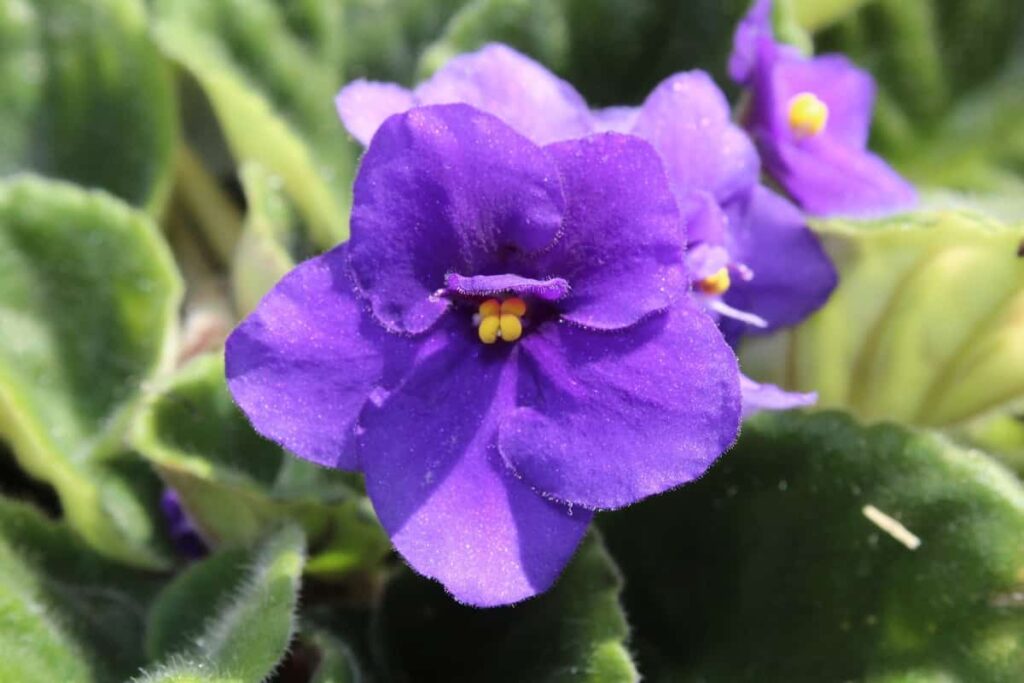
Potting and repotting African violets
A slightly underpotted African violet does better. Repot your African violet plant only into a pot that is one size larger if necessary, and use a potting mix suitable for African violets. Repotting these plants involves picking up the whole plant, lifting it, and replacing it with a larger container without damaging its roots. The crown of the plant should not be covered; only plant the plant up to where they were initially planted. Overcrowding and falling leaves are common signs that a plant needs to be repotted, as are roots that protrude from the soil surface.
Common pests and diseases
Pests
| Pest Name | Symptoms | Control method |
| Spider mites | Feed on the undersides of leaves and produce bronze-colored webs | Spray Dicofol or Neem oil to control these pests. |
Mealybugs | They feed by sucking plant sap. Their feeding causes stunted and distorted leaves. As they feed, they excrete honeydew that can coat the leaves, making them sticky. | For early stages, use insecticidal soap or pyrethrins. In severe cases, spray with acetamiprid, cyfluthrin, or imidacloprid |
Cyclamen mites | Leaves will stunt in the center of the plant, and sometimes, the leaf will curl. New leaves are often hairy, making them look grayish. Flower buds also are stunted and or even fail to open. | Spray with insecticidal soap or products which contain sulfur or tau-fluvalinate. |
In case you missed it: How to Grow Columbine Flowers: A Guide to Propagation, Planting, and Care
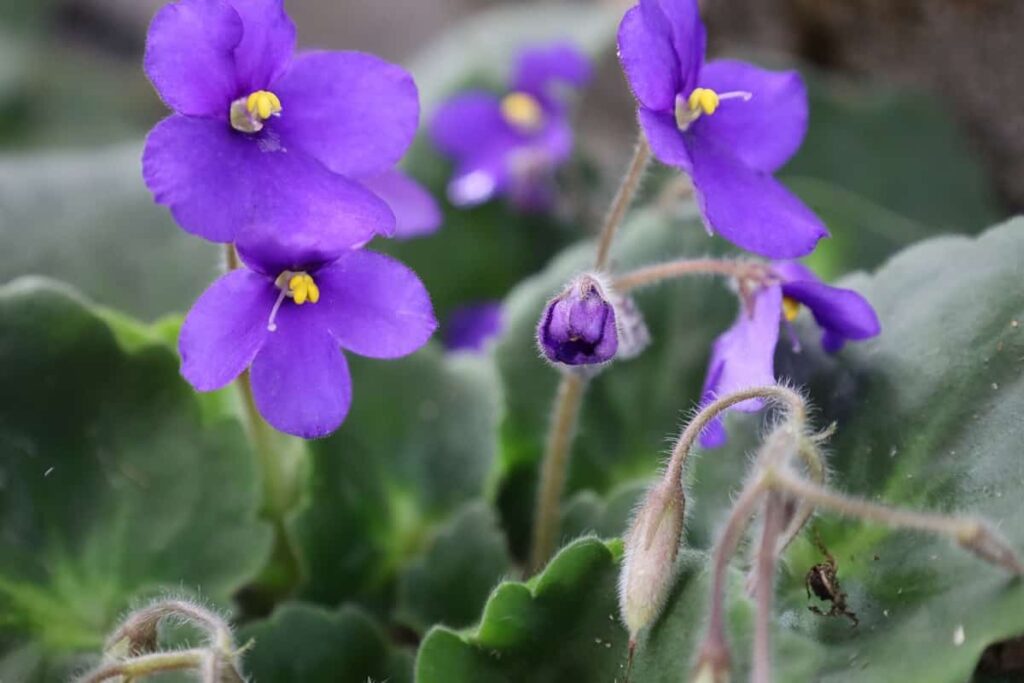
Diseases
| Pest Name | Symptoms | Control method |
| Botrytis blight | Fuzzy gray or brown growth that covers the leaves and stems | Treat with a fungicide, such as Captan or Benomyl |
Crown rot | Crowns and leaves have a weblike substance on them. Leaves are converted into brown or black. | First, isolate the infested plant, remove dead or infected tissue from the leaves, stems, and roots and repot the plant in fresh, sterilized soil. Treat the soil with a fungicide, Benomyl, before repotting. |
Root rot | Leaves will wilt and change their color to yellow or grayish | Remove dead or dying tissue from the leaves, stems, and roots and repot the plant in fresh, sterilized soil. Treat the soil with a fungicide, Before repotting. |
How to get African violets to bloom
There may be a problem with light and temperature and an incorrect humidity level if your African violet does not produce flowers. It is best to place the plant in a bright, indirect light or to use fluorescent lighting to ensure that the room temperature is at least 21°C. When properly cared for, these plants will show off their beautiful blooms all year round.
You can have a happy, healthy plant by providing light, water, humidity, fertilizer, and soil and keeping it free from pests and diseases. African violets prefer tight, cozy pots, but not too tight that they become rootbound. During this time, they bloom for extended periods and flower more frequently. Deadhead the flowers after they have finished blooming because that will encourage the plant to flower more, and hopefully, you will see new blooms in about six weeks.
Conclusion
You can get some flowering companions to help you get through the cold winter days by cultivating African violets, which originate in the southern hemisphere. Despite their delicate appearance, these plants are tough and can be grown on a sunny windowsill in warm climates. As a houseplant, these will enrich the look of your indoor space.
- Profitable Village Farming Business Ideas in 2024
- High-Yield Aquaculture: Fast-Growing Fish for Farming
- Effective Fish Pond Construction Techniques for Beginners
- Irrigation and Water Management in Pineapple Farming
- Blossom to Harvest: Mastering Flowering and Pollination in Papaya Farming
- Pig Fattening Essentials: From Selection to Sale for Beginners
- Raising Wagyu Cattle: A Complete Guide for Premium Beef Production
- Soil Types and Their Water Holding Capacity
- Optimizing Irrigation Schedules for Coconut Groves for Enhanced Yield
- Espresso Your Garden: Coffee Grounds for Healthier Acid-Loving Plants
- The Best Soil Mix for Snake Plants: How to Mix Your Own Snake Plant Soil
- Green Thumb Success: Expert Tips for Cultivating Greenhouse Beans All Year Round
- Bloom All Year Round: The Ultimate Guide to Indoor Hyacinth Care
- Eco-Friendly Gardening: How to Make Liquid Fertilizer from Kitchen Waste
- Ultimate Guide to Grow Anise in Pots: Explore Seed Propagation to Harvesting
- Guide to Raising Chester White Pigs: Discover Breed Facts to Growth Management
- Mastering the Elegance: The Ultimate Guide to Weeping Cherry Tree Care, Planting, and Maintenance
- Ultimate Guide to Planting Garlic in Grow Bags: Growing Strategies for Beginners
- How to Fix Spider Plant Leaf-Related Problems: Natural and Organic Remedies
- 10 Reasons Why Your Tulsi Plant is Shedding Leaves: Home Remedies and Solutions
- Optimizing Growth and Yield: The Advantages of Palm Bunch Ash Fertilizer
- Utilizing Neem Oil Extract as a Natural Pesticide for Hydrangea
- From Soil to Harvest: Various Ways in Which Farmers Can Use AI Tools
- Steps to Encourage and Induce Citrus Flowers: A Comprehensive Guide
- How to Fix Snake Plant Leaf-Related Issues: Natural and Organic Remedies
- Transform Your Garden into a Fragrant Oasis with Raat Ki Rani (Night Blooming Jasmine)
- Discover the Ideal Chicken Breeds for Philippine Farms
- How to Create a Poultry Egg Farm Business Plan for Profits
- Grow Lemon Cucumbers Like a Pro: Insider Techniques for Bountiful Yields
- Ultimate Guide to Caring for Your Pink Princess Philodendron: Tips for Thriving Variegation
- Areca Nut Profit Per Acre: Calculating Yield and Cost of Cultivation
- How Kaveri Chicken is Becoming a More Profitable Breed in Indian Backyards
- Transform Your Barn: 9 Steps to Convert a Horse Stall into a Chicken Coop
- Exploring Suffolk Sheep Disadvantages with Limitations and Challenges
- Guide to Solving Potted Lemon Tree Problems: How to Revive Lemon Tree in Containers
- Steps to Encourage Female Pumpkin Flowers: Best Strategies for More Flowers and High Yields

I have been to various big box stores like Home Depot and Lowes trying to get african violet soil and it can’t be found anywhere. Where can I purchase this?